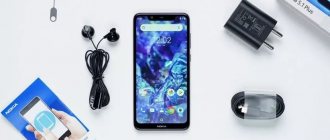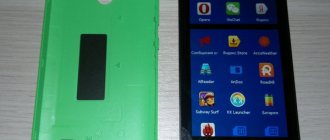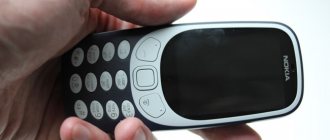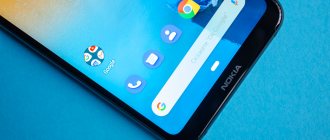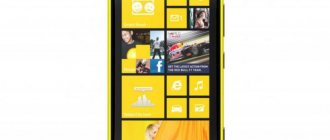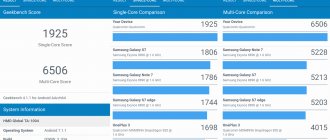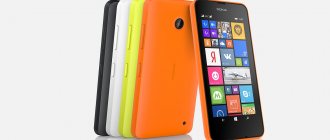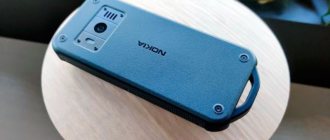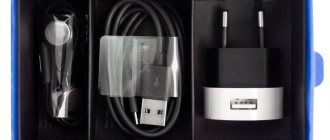Is the Nokia 3250 smartphone something new in the line of Finnish phones or just an improved old one? Some owners of this pipe, as well as its potential buyers, usually ask this question. It is impossible to give a definite answer to this. There are a number of reasons for this. Firstly, as you know, everything new is simply something old that has been well modernized and forgotten on the dusty shelves of human memory. In other words, nothing new can be created without building on what was created previously. Secondly, it is somewhat indecent to accuse a manufacturer of improving its own models, because this is a “sacred” right. In general, I think I managed to confuse you a little with this introduction. Let's start "unraveling"? 
First impressions
The first thing that catches your eye when looking at the Nokia 3250 is its form factor. The smartphone is a candy bar. But not a standard one, but equipped with a keyboard unit rotating 90°, 180° and 270°. The new form of “clothing” is quite a bold decision on the part of the manufacturer. It could cause an ambivalent reaction among the “mobile public.” On the one hand, the new attractive form factor should have inspired the buyer to purchase the Nokia 3250. On the other hand, the design solution looked unusual and could raise concerns among consumers - is it convenient, or is it reliable...
It is impossible to say with certainty what Nokia was doubting. But she decided to release an original youth smartphone. And it was right – Nokia 3250 is extremely popular, we can say that the experiment was a success. Quite a long time has passed since the release of the “musophone” smartphone. Soon, I think we should expect the appearance of a “descendant” 3250 in a similar form factor, but perhaps with a slightly different focus, specialization, if you like.
In any case, the 3250 itself will be popular among its target audience - young people - for a long time. Everything stands for the popularity of the handset - the low price, the Symbian 9 OS (updated, multitasking), the excellent musical abilities, and the excellent camera.
Nokia 3250 – “focused on music”
As the title of one of the sections of this review, I decided to take a slogan probably known to all fans of Nokia phones. If you hear it for the first time, it will probably seem a little strange to you, but once you get to know the 3250 a little, everything will immediately fall into place. According to the manufacturers, this phone is designed to captivate potential audiences precisely with its sound qualities. This audience is teenagers and schoolchildren, for whom the main thing about a mobile phone is not its “telephone side”, but the fact that it has something that could surprise their peers. And I think the manufacturer managed to ensure that the device fully meets the requirements of young people.
Many settings give the user the opportunity to enjoy listening to high-quality music in almost any situation, if only the phone was at hand.
The Nokia 3250 comes bundled with the Nokia Music Headset HS-20. Western colleagues call this device “in-ear headphones,” which literally translates as “in-ear headphones.” Their design is similar to the so-called “droplets”, but differs in that it is continued in the form of small hollow rubber tubes that fit tightly to the ears on the inside and almost completely eliminate the audibility of outside sounds. Tested by me personally, it works! The headset cord is divided into two parts. One, in essence, is a Pop-Port adapter to a 3.5 mm jack, and the second is its continuation. It’s made conveniently, allowing you to use your favorite headphones if you don’t like the standard ones for some reason.
The phone supports the following music formats: eAAC+, AAC+, M4A, MPEG-4 ACC LC, LTP, MP3, AMR-NB, AMR-WB, MIDI, RealAudio Voice, RealAudio7, RealAudio8, RealAudio10, WMA.
Nokia 3250 smartphone review
Nokia took the path of extraordinary design solutions, presenting the Nokia 3250 model. The device has a keyboard placed on a rotating block - something that other manufacturers have not had and do not have. Rotating the block automatically launches the camera or player. .
| A distinctive feature of the Nokia 3250 is its rotatable keyboard block. |
Reader Andrey
asks: “Is this model a really powerful, serious and objective competitor to models such as Sony Erissson P990i, M600?”
It seems to us that the Sony Erissson P990i and M600 are still different categories of smartphones - the latter is “simpler”. Perhaps the Nokia 3250 is more of a competitor to the M600 than to the P990i, although they cannot be called direct rivals either - the Nokia smartphone is designed with an emphasis on multimedia capabilities - music, photography. The M600 does not have a camera at all - it is a tool for “serious” people with “important” matters. This applies to an even greater extent to the P990i. In turn, Nokia 3250 is a youth device at a reasonable price with a set of appropriate functions. By the way, if we talk about its competitors, then first of all we need to remember not the M600, but the W950 from Sony Ericsson - you can compare the models at the end of the test, in the comparison table.
| Video demonstration of Nokia 3250 (wmv, 4.5 MB>>>) |
Appearance
Size: 103.8x 50x 19.8 mm Weight: 115g.
Booster
asks us the question: “
What is the reliability of the hinge?
“Bimmer is puzzled by the same point
.
The device did not come to us first hand, or even second hand - before that it was thoroughly “used”, so we can fully judge the reliability of the Nokia 3250’s rotating mechanism. The reality is that the hinge gradually becomes loose, and the lower part begins to “play” "- not much (about 0.5 mm in both directions), but noticeable. You don’t need to be a philosopher to comprehend a simple truth - the fewer mechanisms, the more reliable the design. According to this principle, it is best to have a classic candy bar. But “simple” is not always synonymous with “good” - there are also such concepts as “convenient”, “understandable”, “accessible”. What is the essence of the turning mechanism? The point is to quickly launch two key functions of the Nokia 3250 - music and photos. We pointed the left side of the block towards ourselves (where the camera is) by rotating it clockwise (when viewed from below) - the camera automatically turns on, and in this mode it is convenient to film yourself in the company of friends and acquaintances, because everything is visible through the viewfinder. Let us now turn the block from its original state by 90 degrees, but in the opposite direction - the camera turns on again, but this time to photograph surrounding objects. If you rotate the keyboard another 90 degrees (180 degrees relative to its “normal” position), then on the front side there will be player buttons—it is for this that this block position is made.
In general, the idea is clear - such a mechanism makes access to the camera and player easier. But at the same time, we must understand that the rotary design is, by definition, less reliable than the traditional one.
| Nokia 3250 |
The material of the main body is matte, pleasant to the touch; Only the lid and the back surface of the rotating part of the case are made of hard, glossy plastic. They seem designed to get dirty all the time: even the display is not as susceptible to dirt and scratches as these parts. In other places, however, there are practically no fingerprints left, and the body is also not very susceptible to scratches.
| View from above | Bottom view |
The smartphone lies comfortably in the hand, does not slip at all, and is comfortable when talking with it. But when it comes to ease of handling, the size takes its toll: you don’t want to wear such a tube in jeans and a shirt; preferably in a jacket, jacket or bag. The build quality does not cause any particular complaints, except that the lid is not very stable and becomes slightly loose over time. No creaks, crunches or other unpleasant phenomena were noted.
| Right view | Left view |
The cover is not removed in the most convenient way: you need to press two pressing buttons on both sides of the cover, which are also located flush with the body - you won’t be able to figure it out the first time without instructions.
Under the battery there is a slot for a SIM card, implemented in the form of a metal holder. The card is inserted into it and pressed with a latch. Main keyboard
The numeric keypad consists of four rows of fairly wide rectangular buttons. Although they are located in the same plane and are not separated by any inserts, the likelihood of incorrect clicks is minimized due to the “wave” shape. Subjectively, the keys are comfortable: your fingers don’t get tired even after long typing. The material of the buttons is soft matte plastic, the symbols are painted on top of it and are perfectly readable. In commercial versions, the keyboard has Cyrillic.
Below the display there is a control unit: a 5-position joystick surrounded by soft buttons and call and reset keys. To the side of them is a menu button (on the left), an editor key and a correction button (on the right). All of them are easy to use; The only drawback of the joystick is the beveled corners, due to which the finger sometimes tries to fall on the buttons surrounding it. The joystick itself is metal, and all the keys next to it are made of soft matte plastic.
Soft buttons and navigation are programmed for “quick” functions. If the active standby mode is turned on, then only soft buttons can be programmed.
The backlight is bright, combined: mostly white;
the call button is illuminated in green and the reset button in pale red. It allows you to work calmly in any lighting conditions. The backlight operating time varies from 5 to 60 seconds in 5 second increments. Additional buttons
By turning your smartphone over or turning the rotating block 180°, you will see a “musical” keyboard consisting of four buttons: play, fast forward/rewind and stop. In photo mode, the rewind keys are used to adjust the zoom, the stop key is used to stop video recording, and the play button is used to release the shutter.
| "Musical" keyboard |
At the top, according to Finnish tradition, there is a switch:
TFT
display It’s difficult to classify the display as a plus of the model: its resolution is only 176x208 pixels. The grain is much coarser compared to, say, the N80, but the color quality is still good. In the sun the image fades somewhat, but remains quite “readable”.
The photo ID can display the caller's photo on the screen - the quality of the photo is not satisfactory, but the size could be larger. When operating the camera, the display serves as a viewfinder.
To design the interface, 3 pre-installed plus downloadable themes are available.
Background images, greetings, and screensavers are implemented as standard. The display shows two modes: normal and active. In the usual one we see network and battery indicators, large - time (in the upper right corner, the clock can be both analog and digital), on the right - the name of the operator, and below it - the date and day of the week. In active standby mode, this is supplemented by a line of “quick” function icons and a line with calendar notes. The maximum number of icons is 6, their set is set in the menu “Tools” - “Settings” - “Phone” - “Standby mode” (“Tools” - “Settings” - “Phone” - “Standby mode”). To do this, active standby mode must be turned on. Camera
1600×1200 pixels (2MP), ZOOMx4, video.
lex
I'm wondering: does the Nokia 3250 have a flash and can it work as a flashlight?
Unfortunately, there is no flash and, accordingly, no flashlight either. Why? Perhaps because the developers really wanted to make the Nokia 3250 as “youthful” (read, “more affordable”) as possible - so they saved money. But on the other hand, photography is one of the key functions of the device and we would not deprive it of such an important element. Let's see how the camera performs in terms of quality. But first, a few words about her.
The camera is located on the rotating part of the body at the bottom left. During normal shooting, the module rotates 90° counterclockwise, and for self-portraits - at the same angle, but in the opposite direction. The shooting is turned on and forced - through the menu, then you don’t need to rotate anything, but taking photographs in this position is not very convenient - the camera turns out to be pointed to the side.
When shooting, your fingers try to block the peephole. Another downside is that there is no protective curtain, which is why the lens often gets dirty. But it is unlikely to “hurt” it due to the plastic edging that rises above the peephole. There is no self-portrait mirror, nor is there a flash.
When you rotate the body, the shooting mode is activated automatically; It is better to hold the phone with both hands. And in general, it seemed to us that the Nokia 3250 is not a device for “one-handed” use; you involuntarily pick it up with both limbs, firstly, because of its solid size, and secondly, because of the unusual “rotational” design - you start the smartphone twist in your hands like a Rubik's cube (if anyone remembers such a puzzle). But let's get back to the camera.
The interface during shooting looks like this:
- In the upper right corner is the frame counter
- In the bottom right and bottom middle are photo/video mode and settings icons
- In the lower left is the “Options” menu
- In the upper left there is a command to exit to standby mode and a zoom scale (it is 4x, smooth, adjustable by the horizontal positions of the joystick or the rewind keys).
The Options menu includes Night Mode, Timer, Video and Gallery Access, Color Tone, White Balance, Shooting Tips, and Picture Settings. White balance is adjustable in 4 levels: automatic, solar, incandescent and fluorescent. The color tone allows you to activate different effects: sepia, negative or black and white.
The Picture Settings menu allows you to change the picture quality (high, normal and basic), resolution (1600x1200, 1152x864, 640x480) and storage device (phone or card).
The video settings are not much different. Available resolutions are 176x144 and 128x96 pixels. The duration of the options is not rich: there are only two options - short and maximum. Videos, like pictures, are saved in the “Gallery” menu in the appropriate folder. They can be sorted by size, title, format or size. You can mute the sound while recording. Frequency - 15 frames per second, format - *.3gp. Example video>>>
As always, we test the camera quality on a test table:
| Test table snapshot |
The Nokia 3250 camera disappointed us - despite the fact that it is stated to have 2 megapixels (1600x1200 pixels), in reality, if we compare the image with the standard taken by the Canon PowerShot A620 camera, the smartphone resolution is closer to VGA, that is, only 640x480 pixels. In any case, horizontally its matrix distinguishes no more than 500 lines. In this regard, we have two versions: the firmware with which we tested the smartphone (v. 3.05) is far from perfect, or we have a pure scam - when the “megapixels” are obtained by a banal stretching of the photo and do not correspond to the actual number of sensitive camera elements.
But the low resolution of the image is not so bad. The photo clearly shows how a greenish strip as thick as the rectangle extends from the horizontal rectangle at the bottom of the picture (a block of vertical oblique lines) to the right and left, as if it had been smeared. The same effect is observed in the center of the composition. Most likely, there is an interpretation error, in other words, the problem is in the “software”. We hope that the problem has been fixed in commercial copies.
| Test pattern taken with a Canon PowerShot A620 camera with a resolution of 1600x1200 pixels | |
| Resolution - 1280x960 pixels | Resolution - 640x480 pixels |
How to read a test table?The test pattern is designed to evaluate the quality of the lens-matrix combination. In positions 1, 2, 3 you can get a quantitative assessment of the camera’s resolution: the numbers next to the lines show the number of lines x100. The place where individual lines are no longer distinguishable is the resolution indicator. In positions 1, 2, 3 you can see the resolution along the short side of the frame horizontally, vertically and diagonally, respectively. For example: if in figure 1 the lines merge next to the number 8, then this means the vertical resolution is 800 lines. With an aspect ratio of 0.75 (frame size 1600x1200 pixels), we get the actual image resolution of 1067x700 pixels, which is approximately 0.85 megapixels. In position 4 and similar ones you can see chromatic aberrations - purple and green halos around objects. The better the lens, the less noticeable ghosting will be. In position 5 you can see whether the circles are displayed correctly and with what distortions the diagonal lines are drawn. And in position 6, moire is observed - an optical illusion that occurs when a regular (for example, mesh) pattern of the original is combined with a regular lattice of the camera phone’s photosensor. In addition, the overall view of the table can show geometric distortions from the optics known as “barrel” and “cushion” (curves on the sides and vertically). |
Connectors, ports, slots
The model is not rich in them: there is only a connector for a “thin” type charger (AC-3) and a standard Pop-port for accessories - a USB cable, a headset, etc. Their unusual location on the right side of the phone in the middle is dictated by the design: you can’t place them on the rotary block.
The memory card slot is not immediately found - it is hidden between the rotating block and the main part of the body. To insert or remove a card, you need to turn the keyboard unit and pry off the slot cover (there is a corresponding designation on it).
| Without instructions, the slot is difficult to find |
There is no IR port in the model.
Memory, file operations
Built-in: 10 MB, flash card - microSD (T-Flash) up to 1 GB, file manager
Riffin
wants to know, “What is the internal memory capacity of the phone?”
The amount of memory available to the user is 10 MB, which is consumed dynamically. The memory can be increased up to 1 GB using a microSD card (T-Flash). Music files can be read from it perfectly, and ringtones or photos can be sent to a number. Operations to transfer files from and to the card do not take much time.
The file manager is defined in a separate menu (it is located in the “Personal” - “My own” menu) and is implemented in the form of two bookmarks: one for the phone, the other for the card. The memory status can be viewed in the corresponding “Options” item. Files and newly created folders can be moved, copied and deleted; To delete an object, just select it and press the “C” key. There is an option to “Select All”.
Operations with a memory card are performed in the “Tools” - “Memory” menu.
Here you can also see the state of the memory, as well as format it or make a backup copy. Communication with other devices
Data transmission/reception speed table
| Communication type | Measured data rate | What was the connection? |
| USB cable | about 500 KB/s | Laptop DELL Inspiron 510m |
| IR port | absent | — |
| Bluetooth | about 64 KB/s | Laptop DELL Inspiron 510m |
Communication can be carried out via data cable and Bluetooth. Data cable CA-53 with a USB connector for communication with a PC is included in the kit. Conveniently, Nokia 3250 is detected as an external storage device (Mass Storage Device) without any drivers. When you connect your Nokia 3250 to your computer, your smartphone will ask you how you want the PC to identify the device: simply as an external drive (for sharing files), as a phone (for working with Phone Tools) or as a media player (the last two modes require software installation). It’s convenient that the headset jack does not interfere with the connector—you can connect both the cable and the charger at the same time. By the way, when working with a connected USB cable, the device cannot work as a phone.
Bluetooth - version 2.0 (full speed), activated either from the “Connectivity” menu or a designated “fast function”. In the interface - activity status (on/off), visibility to others and device name. The Remote SIM mode option allows other compatible devices to use the phone's SIM card to connect to the network. A separate horizontal tab contains a list of devices with which the pair was created. In the “Options” menu, use the “New Paired Device” command to start searching for devices. The “Set authorized” function allows you to connect to discovered devices automatically, without re-entering the code.
The kit includes a disc with Nokia PC Suite software. Nokia Audio Manager 5.0 transfers music files from a CD to your phone. Music Studio, included with Nokia Audio Manager, allows you to organize and copy audio files. The phone is also compatible with Windows Media Player.
The Sensor application is designed to create personal pages on the phone that will be visible to other nearby application users; You can view their pages in the same way.
The Lifeblog application allows you to create and edit a mobile online diary, as well as upload photos and videos there.
WAP browser version 2.0 is implemented as standard (you can use the wap site https://waping.ru for testing). The device supports xHTML browser with TCP/IP connection. There is support for EDGE (Class 10, download speed up to 236.8 kbps), and GPRS - Class 10, download speed up to 62.4 kbps.
The Push-to-Talk application provides direct voice communication with the interlocutor.
In this case, a connection to a regular voice communication system is not used, so some of its services (for example, an answering machine) are not available in PTT. A call can be sent to one or several subscribers. Notification of an incoming call is carried out by a short tone with information about the caller displayed. So far, no Russian operator really supports this function. Accessories
The basic kit includes:
- Apparatus
- Battery BP-6M
- AC-3 charger
- USB cable CA-53
- Wired headset HS-20
- microSD card (Trans Flash) MU-28 512 MB
- Installation disc with software (Nokia PC Suite)
- Instructions, User Guide, Quick Start Guide, Product Brochure
- Adapter SA-44
Battery BP-6M - Li-ion, capacity 1100 mAh. This, according to the manufacturer, is enough for 3 hours of talk time and 245 hours of standby time. The characteristics are not entirely clear: the N80, for example, has a much smaller capacity - 820 mAh - enough for the same talk time, and the N91 is capable of talking for 4 hours with a battery capacity of 900 mAh. But in terms of waiting time, Nokia 3250 is ahead by about 50 hours.
The AC-3 charger restores the phone in about 80 minutes. The included SA-44 adapter makes it possible to connect other types of chargers (even ACP-7E from Nokia 1100).
| The HS-20 headset is equipped with a standard 3.5″ jack - connect whatever you want. But her quality is quite decent. |
Menu
Nokia 3250 is the first smartphone on the Russian market to run on the Series 60 3rd edition platform. The average consumer will not notice any special innovations in the updated software. Convenient features have been added in some places, and some things have been changed at the interface level. A special feature in s60 v3.0 has been made to deal with copyrights on content - now you can’t download anything that gets into your smartphone. And, most importantly, the Series 60 3rd edition is not compatible in a software sense with previous versions, in other words, applications from other Nokias will not work with the 3250. For the third edition, our own applications and utilities are created. And since Nokia 3250 alone supports s60 v3.0 for now, this will create more problems for consumers than convenience. True, Nokia N91 is on the way, but this is by no means a mass device. It will take at least a year before Series 60 3rd Edition is more or less widely popularized.
| Normal and active standby modes in standard Nokia theme |
The main menu can be displayed either as icons (5 rows, 13 icons) or as a list. The “Tools” menu (12 icons) is also shown. Sub-items are displayed only as a list. In some cases, horizontal bookmark menus are provided to make working with the device easier: for example, to view the memory status, phone settings and contact list.
Navigation can, in principle, be carried out with just one joystick, but when fully working with the handset, of course, you cannot do without soft buttons. The right one returns to the item above, and the reset button exits to standby mode.
There are 3 themes available for interface design: Nokia Theme (standard), Blaster, Hiphop. Plus, it is possible to download new themes. “Short call” functions are supported for soft buttons (in all cases) and joystick (only when active standby mode is disabled). There are 60 different functions available for this.
| Themes: Blaster (left) and Hiphop (right). |
Messages
When entering an SMS, the screen displays a line for the recipient's number and 6 text lines of approximately 25 characters each. There is support for composite SMS, pictures in messages, and a mailing list. Delivery confirmation works flawlessly, you just need to activate it in the “Options” - “Settings” - “Text Message” menu. The delivery period is set at the same point and varies from 1 hour to unlimited; All delivery reports are saved in a separate folder. A single signal is provided for SMS and MMS; it can be either special signals or melodies (built-in and downloadable). There are 10 editable templates available for creating messages. The “*” button calls up the symbol table, and “#” is responsible for the input mode. The typing procedure is simplified by a button with a pencil symbol - it allows you to quickly activate T9 input, numeric mode, and select the desired character or language.
MMS support OMA 1.2 allows you to combine and send images, video, text and audio clips as MMS to a compatible phone or PC; You can make presentations of several slides. The maximum message size is 300 KB.
The email client allows you to send, view and store email messages (including on a compatible PC).
There is access to work and personal mailboxes; The machine supports SMTP, POP3 and IMAP4 protocols. Telephone Directory
It uses dynamic memory. When entering each new person, the first name, last name, company and position, home and mobile numbers, fax (home and work), video call number and e-mail are indicated. Additionally, you can enter your birthday, home and work addresses, work and home web and e-mail addresses. You can use both built-in and downloaded and recorded melodies from the recorder as personal ringtones. They are assigned to both individual names and groups. The same is true with photographs. There are no preset groups; the user sets them arbitrarily.
Contacts on the SIM card are displayed as a separate line in the Options menu. Here, in the corresponding item, you can view the memory status. The presentation of the names themselves can be configured separately: “Last Name-First Name”, “Last Name-First Name”, “First Name-Last Name”. You can back up your phone book.
The bottom line in the interface is designed to search for the desired contacts, which automatically begins when you enter the first letter. Keys 2-9 are programmed for “speed dialing”.
Call lists are located in the “Log” menu, where the “Recent Calls” item displays missed, received and outgoing calls.
The presence feature allows you to check the availability of a subscriber before calling him, but it is not yet supported on our networks.
Entertainment
| Games | 2 built-in: Punkwigs, Snakes |
| MP3 player | There is |
| Radio | There is |
| Video player | formats 3gpр, mpeg4 |
The player is the main function of the Nokia 3250. Firstly, the smartphone finally includes a full-fledged stereo headset of excellent quality. Secondly, there are special buttons on the rotary block for the player. We can say that Nokia 3250 is the Finnish answer to various kinds of “rockers” and “Wolfman” (for those who don’t know, the ROKR series from Motorola and the Walkman from Sony Ericsson).
The player supports the following formats: eAAC+, MPEG4 AAC, MP3, ARM-NB, ARM-WB, 64-voice polyphonic MIDI ringtones, RealAudio Voice, RealAudio7, RealAudio8, RealAudio10, WMA. It is launched either through the main menu or a designated “quick function”. The interface is similar to the Nokia N80: the same crowding of symbols in the lower half of the screen with the upper half empty. Control points are located on the left of the screen and contain forward and rewind, stop, download melodies, “music library” (player menu) and a list of all songs. The volume is adjusted by horizontal positions of the joystick in 10 levels.
| Phone in player mode and interface |
The sound quality is excellent, but unlike the N80, where the volume reserve is subjectively small, here, on the contrary, the volume level is too high - you have to turn it down. Among the settings, noteworthy is the “Audio settings” menu that is absent from the N80, in which the following are available:
- Equalizer: 5-band, adjustable, 7 types: bass, hip-hop, pop, rock, r&b, rock, acoustic and default setting. In addition, you can create your own settings. The sound quality really changes noticeably when adjusting the equalizer.
- Balance: 8 gradations.
- Reverse (echo, to put it simply): there are 8 types, including such exotic ones as “bathroom” or “underwater”.
- Stereo expansion.
- Bass Boost: On/Off only; There are no special settings here. But the increase in lower frequencies is clearly heard.
The rest of the settings are the same as the N80: there is random and repeated playback, creation of your own playlists, output of music to the speakerphone or in the background.
All melodies (including downloaded ones) can be used as ringtones; Files can also be read from a flash card without any complaints. The “Music Library” menu deserves special attention: it contains lists of tunes by artist, genre, composer and playlist. The Track-lists menu displays recently played and most played songs, as well as the latest music updates. In the “Music library details” item, you can view information about the music library: the total number of tracks, the total time and the amount of free memory in the phone and on the card.
When there is an incoming call, the song pauses and then automatically continues playing from the interrupted point. Continuous operation time in playback mode is about 10-11 hours.
The radio in the Nokia 3250 is familiar to us from previous devices from Suomi: the same interface (on the left - controls, in the center - the name of the station, at the top - a 10-level volume scale) and the same settings. It starts in the same way as the player. There is a memory for 20 stations, and manual movement through the range is available in two ways: either enter the desired frequency from the keyboard, or set the step using the vertical positions of the joystick (the step is 1 MHz for the whole part of the frequency and 0.5 MHz for numbers after the decimal point). Like music, radio can be output to the speakerphone or left in the background; The quality of reception is not satisfactory. Support for the Visual Radio service allows you to view the video content of the station (menu “Options”/”Enable VideoOptions”/”Start Visual Service”). Before doing this, you need to define an Internet access point in your device. Depending on location, the number of available stations may vary; You can view the available ones in the menu “Options” - “Station directory”. But you don’t have to watch it - it doesn’t work in Russia yet.
The video player plays videos in full screen mode. There is a search for clips by the first letters of the title. The playback quality is generally good, although there is some slight stuttering. Videos are sorted by date, title, size or format. There is a “full screen” mode, but in this case the playback quality decreases - the image begins to “float”. You can mute the sound while the video is playing. If there is an incoming call, the video player automatically closes and the video time is reset - this is a clear inconvenience. Note the ability to download streaming video using the RealOne player.
We found the Flash Player item in the Media menu.
But the system refused to play uploaded files with the *.swf extension, citing the fact that they were “damaged.” At the same time, files were opened in the Internet browser of a personal computer without problems. Applications
The calendar is equipped with traditional functions: entering notes, sending them via SMS, MMS, Bluetooth and infrared. There are 4 types of calendar available: month, week, day overview or to-do overview (menu “Options” - “Settings”). When you enter new notes, you specify their type: meeting, memo, anniversary, or to-do.
Notes placed in the to-do list can be sent via SMS, MMS or Bluetooth. The search is carried out by phone number, web or e-mail address.
The alarm clock is set from the “Clock” menu, and its melody is also configured there. It also works when the phone is turned off.
The calculator is implemented as standard; operations with memory, percentages, and negative numbers are provided. There is a square root.
The converter is multifunctional, it can convert not only currencies, but also temperatures, measures of length, volume, area, energy, mass, power, pressure, time, speed.
The voice recorder is located in the "Media" menu.
The recording length of one fragment was disappointing: it was only one minute. Entries are saved in the “Gallery”. They can be sorted by date, size or name, transferred to MMS or via Bluetooth, or moved to a memory card. There is a search by the first letters of the names of records; they can also be set as a ringtone. Sound
| Speakers: speech (left) and polyphonic (right; it is located on the bottom end) |
The quality of the speech speaker is not satisfactory;
The volume margin and speech clarity are good. During a conversation, the speakerphone is activated in the “Options” menu (this is the topmost item); The sound volume can be adjusted in 10 levels. The polyphonic speaker is located at the bottom end of the handset, and the phone reproduces 64-tone polyphony perfectly. Operating time
With a conversation rate of about 20 minutes a day, Bluetooth constantly turned on and using music and radio, the phone worked reliably for 2 days. So users can count on this operating time. Those who are especially thrifty will certainly find a way to extend the life of their smartphone up to 3 days.
| pros |
| The player is the key function of the device: convenient control, high-quality headset, user-friendly interface |
| Extensive capabilities of the Series 60 v.3.0 platform |
| Works as a Mass Storage Device when connected to a PC via USB cable |
| Minuses |
| Relatively large (especially in thickness) body |
| Camera of mediocre quality, no flash |
| Play in the keyboard unit that appears over time |
Opinion: due to the fact that the smartphone is for youth, it can be forgiven for its relatively large dimensions, its unimportant camera, and some other flaws. If you want the most “advanced” and expensive device, then the Nokia 3250 is not for you. The main function of the model is the player, around which everything revolves. Based on these considerations, we can predict that the new product will gain decent popularity and likely success in competition with competitors’ “music” phones.
We thank the information portal MForum.ru for the review provided.
Nokia 3250 prices
All Nokia 3250 prices as of 10/02/2020
Rotary block
We have already mentioned several times the unusual form factor of the 3250. This is not a clamshell, not a rotator, not a flipper, it looks like a candy bar, but the candy bar is very non-standard! Rotating the keyboard unit by 90 and 270 degrees activates the camera; rotating it by 180 degrees launches the media player and gives access to its control using special keys. You need to get used to turning the block; sometimes unpleasant situations arise when you turn it 180 degrees not very quickly - and then at 90 degrees the camera is activated. And when the block reaches the 180-degree position, the camera application does not close, but only collapses, and then you have to close it manually.
In conclusion to the story about the rotary block, it is worth noting that it is not very reliable. No, no one’s keyboard has ever fallen off, but it’s a fact that after a couple of months the bottom block becomes loose and begins to “play” a lot.
2 megapixel camera
The camera in Nokia 3250 is located at the bottom right side when looking at the device from the front. The camera is automatically activated by rotating the keyboard unit 90 degrees. If you want to shoot from a standard position, you will have to enable the camera from the menu. There is a second operating mode of the camera – taking a self-portrait; for this you need to turn the keyboard unit with the “eye” of the camera towards you.
From my own experience, I can say that activating the camera in this way is not a very convenient thing. Not only do you have to perform “rotary operations” every time to take pictures (on older firmware the camera application did not always start!), but you also lose the pleasure of taking pictures with a “hidden camera”. On a simple candy bar (or clamshell) you can pretend to be looking at the screen, and at the same time take pictures unnoticed.
Camera settings. Image resolution: 1600x1200 pixels, 1152x864 and 640x480 pixels. Image quality: High, Normal, Basic. Shooting option: normal, series of shots, timer (10, 20 or 30 seconds). There is a night mode, the ability to adjust the white balance - Sunny, Incandescent, Fluorescent. Effects: Black&White, Negative. There is no flash in the device, but there is a night mode. As in many devices, turning it on greatly affects the speed of operation; you will not be able to shoot moving objects, while for static images this function works quite well - even in low light at dusk you can shoot.
The phone takes pictures at a maximum resolution of 1600×1200 with JPEG compression. The image quality is not the best, but acceptable for mobile cameras. Video recording takes place in 3GP format with a frequency of 15 frames per second and AMR audio quality of 12.2 kbit/s, with a resolution of 176x144 pixels.
I suggest you look at the photographs taken with the built-in camera of the Nokia 3250 (click on the thumbnail to enlarge the image):
Nokia 3250 runs the Symbian 9.1 operating system (this is the third edition of the S60 platform). The new OS gives the phone some advantages, but it also has its disadvantages. These disadvantages include incompatibility with programs written for the first and second editions of the S60, and programs for the third edition are rewritten rather slowly. In the first months after the 3250 appeared on the market, it was almost impossible to find software for it, however, today there is already enough of it (as you can see by visiting the section with games, themes and programs for the Nokia 3250 on mobime.ru).
However, if software for Symbian 9.1 is not enough for someone, there are always Java applications, compatibility with them is complete. The phone supports MIDP-2 profile with compression, allowing you to install applications up to 2 MB in size. By the way, there is also a section with java games on mobime!
Incompatible applications
Nokia 3250, which has a different firmware from previous models, is the first smartphone with version 9.1 of Symbian OS. It comes along with various innovative features, but also with one very significant drawback: the platform is not compatible with older applications. According to user reviews, when you try to install several programs on your phone, the same error message is displayed every time: “The download is not supported by the system.”
This limitation complicates the situation, since software vendors will now be preparing new versions of their products, while users will spend extra time searching for these new versions, downloading them, pre-registering, etc.
In the middle of the display you can see the general active standby mode, which first appeared in the Nokia 6681. The Nokia 3250 has six icons for quickly activating frequently used programs (instead of five in previous models). All icons can be customized according to user preferences. Below this panel you will see the events of the day on the calendar or the first event of the next day. The number of pending tasks, the name of the associated MP3 file (if recently played), and the radio frequency indicator/station (if the radio was active) are displayed in the same area. In addition, all the blocks listed above are active, that is, by marking them, you can instantly go directly to the calendar, task manager, MP3 player, radio, etc.
There is one drawback however. All tasks performed in active standby mode are controlled using the joystick, which limits functionality. They can be disabled to quickly open frequently used applications. However, standby mode is deactivated. In this case, Nokia 3250 looks like an old smartphone.
Screen
The Nokia 3250 display has a resolution of 176x208 pixels. This is not much - Finnish smartphones of previous generations were equipped with such screens. However, given the youth-budget orientation of the phone, we won’t particularly criticize the display. It has excellent brightness and grain that is not too noticeable.
I’ll note right away that the font, due to its low resolution, is very small (just pixelated) and many who bought the Nokia 3250 begin to complain about this and look for ways to enlarge it. Unfortunately, there is no such option. If you have poor eyesight or are just a fan of large letters, take a look at other phones (better than other manufacturers; Nokia smartphones always have small fonts).
The low screen resolution, coupled with the new Symbian 9 OS, adapted for higher resolutions (320x240 and higher), makes some images on the display not of very high quality. However, if you don’t often look at better displays, you will get used to it. 
Nokia 3250 :: Review :: Communications
The phone supports Bluetooth 2.0 + EDR, a large number of profiles are supported, but there is no A2DP profile, which means that you cannot play sound using a Bluetooth stereo headset. Although, taking into account the quality, selection and cost of such headsets, this opportunity does not provide much value, nevertheless it does not exist, which is of course a minus, not a plus.
There is no infrared port and this is a bit of a strange solution for a youth phone, while most new Nokia smartphones are again equipped with this function. Connection via cable - when connecting, the user sees a request about how exactly he wants to use the phone in this case. There are 3 options in total: Media Player, synchronization with PC Suite, use as a disk drive. When used as a disk drive, the phone notifies that it should go to an offline profile and, after confirmation by the user, appears in the system as a disk. After disconnecting the cable, the phone automatically activates the previous profile before connecting. Support for EDGE (Class 10) is not superfluous at all; when connected, there is an indicator that shows that EDGE is being used, and not GPRS.
Memory
Nokia 3250 has 10 MB of internal memory, which is not enough by modern standards. There is an expansion slot for microSD cards (TransFlash). Nominally, Nokia 3250 supports memory cards with a capacity of up to 1 GB. But when working with a card with a capacity of 512 MB, noticeable “brakes” already appear; perhaps this is only a temporary phenomenon and is typical for lower firmware. In general, the speed of accessing the memory card is quite high. The difference in the time it takes to launch applications from the phone memory and from the card is about two seconds.
Nokia 3250 :: Review :: Camera
The 2 MP camera, without flash, has 3 working resolutions - 1600x1200, 1152x864 and 640x480. The entire interface for working with the camera is designed in horizontal orientation. For control, as already mentioned, the player control keys and the joystick can be used. There are minimal settings here: quality (basic, normal and high), image resolution and choice of memory for saving (internal or memory card). There is a night mode, burst shooting, and a self-timer. You can change the white balance (automatic, sunny, incandescent, fluorescent) and color tones (sepia, black and white photo, negative). In general, according to Nokia's idea, a music phone should not be able to do too many things for taking photographs. 
On the phone screen, the pictures do not look very good, which is more likely due to the screen itself than to the quality of the pictures. On a PC screen, everything is much more fun and interesting, the camera 3250 shoots much better than one would expect from the appearance of the camera block, which does not look as convincing as, for example, in the N70.
Table ?Examples of photography? Nokia 3250 | |
| Photos | |
| Video |
The video is not particularly pleasing with its capabilities, the jerks that were present when shooting in the prototype have not disappeared, the quality of the video, as well as the photo, remains the same. It seems that no attention was paid to the camera’s operation during the last month of preparing the phone for sale; everything works exactly the same as in the prototype. However, the photo quality is at a very acceptable level.
The maximum video resolution is only 176x144, which is not impressive compared to N-series smartphones.
Nutrition
The tested Nokia 3250 phone has a Nokia BP-6M battery with a capacity of 1100 mAh. This is enough for an average of one and a half days of intensive use. In media player mode, the operating time is about 10 hours. Battery charging time is just over two hours. The connector for connecting a charger is standard for the latest Nokia models. The new connector is a couple of millimeters smaller than its predecessor. But if you have chargers from older models of this manufacturer, do not despair; fortunately, the Nokia Charger Adapter CA-44 is included in the standard package. This is an adapter from the old type to the new one, with its help you can charge your battery without having a “native” charger at hand, but having the old one.
Communications
Of the wireless communication interfaces with other devices, this model has only BlueTooth version 2.0. This technology provides high data transfer speeds. But, there is one “but”... In my opinion, a very big disadvantage for a music smartphone is the lack of support for the A2DP Bluetooth profile. If any of the readers do not know what this is, let me note that this is a protocol for transmitting a stereo audio signal to compatible Bluetooth headsets. Those. You can listen to excellent stereo music wirelessly. Unfortunately, Nokia 3250 will not help you with this.
The phone can be connected to a PC or laptop using the Nokia Connectivity Cable CA-53, which is included in the standard package. When you connect the cable to the phone, a window for selecting the connection type appears on its display (the phone, of course).
The smartphone can be connected to a computer using proprietary software (PC Suite) - this is the first method.
The “data transfer” connection type allows for simple file exchange between a computer and a phone without installing additional drivers (the phone will act as a regular “flash drive”).
The connection between the phone and PC does not cause any problems, both types of connection work at a good level, the transfer speed is quite high.
Nokia 3250 supports GSM 900/1800 cellular communication standards. The quality of communication, as always for Nokia, is at a high level. The phone has reliable reception even in places with poor operator coverage.
Architecture
The build quality of the phone is at a very high level. All elements of the case are held together very well and give the impression of very high strength. In other words, Nokia 3250 is one of the best mobile phones on the market in the security category. The sides of the device, including those that form part of the lower rotating segment, are made of metal. They cover all parts of the case so firmly that accidental damage is simply impossible. On the other hand, if you set yourself the goal of how to disassemble the Nokia 3250, you can spend a lot of time on this.
The only elements that break the metal sides of the phone are the Pop-Port cap, the charger connector and the latches on the back cover. The Pop-Port cover is made of hard rubber and contains the company logo. However, it is not secured well enough, and this is one of the significant shortcomings of the smartphone. Nokia 3250 is a music phone that requires frequent use of connected headphones, and the need to regularly remove the cover significantly reduces all the advantages of using it.
The back cover of the device can be opened by pressing the above latches located in the bottom area, which look like rectangular pads. The back cover has a huge glossy Nokia logo. Once the cover is removed, you will see a BP-6M lithium polymer battery, which is significantly larger than what is found in other phones in the 60 series. The developers have officially announced 245 hours of battery life for the Nokia 3250 (the battery has a capacity of 1100 mAh) in standby mode and 180 minutes of talk time. As follows from user reviews, one battery charge is enough for 10 hours of listening to music.


